buxhall village
As you walk around the village, you'd be forgiven for thinking that there is little of note in the way of sights-to-see. After all, Buxhall doesn't host a sprawl of small retail outlets, and it no longer hosts a village shop, post office, or currently, as of writing, an open pub. But it did, once upon a time. It used to have many of these things, and though they have disappeared from the fabric of day-to-day use, they have not vanished completely from sight. The joy is still being able spot them.
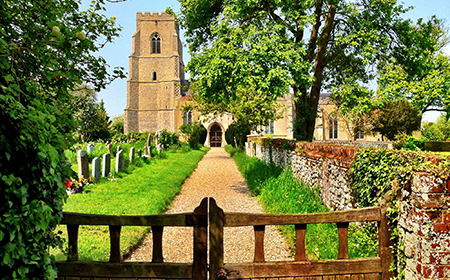 Obviously, this large and beautiful church has not disappeared from view, and can actually be seen from many of the surrounding villages, and it is still in use by the Church of England today as Buxhall Parish Church. It is one of seven churches within the Combs and Finborough Group.
Obviously, this large and beautiful church has not disappeared from view, and can actually be seen from many of the surrounding villages, and it is still in use by the Church of England today as Buxhall Parish Church. It is one of seven churches within the Combs and Finborough Group.
The current church dates mainly from the early 14th , but is believed to be preceded by at least two others. It is built mainly of flint with an imposing tower 95 inches in height. Outside, the south porch has a niche above for the image of the Virgin Mary. The interior of the church was renovated in the 1870’s but many earlier features remain. The octagonal font is mid 14th century and at each corner a buttress rises from a human head. Some medieval glass still survives in the chancel, and there is other glass in the south nave windows - all in excellent condition. Also in the chancel are three marble floorheads, one dated 1692, another 1584, and the painted arms of George 1. The chancel roof was rebuilt in 1656 and is carved with the initials J.H. F.G and T.C. St Mary’s has six bells – the tenor weighing an impressive 15cwt. The bells are in regular use today.
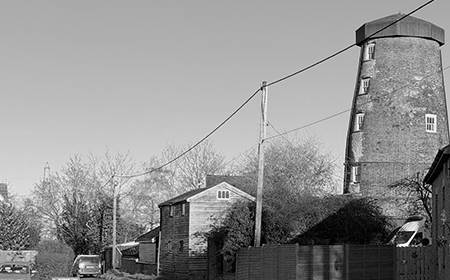 The first reference to a mill in the village was in the Domesday Book of 1086 and was probably a water mill, sited south of the present mill below Kiln Lane, where once there must have been a good head of water. However, the current standing mill was built in 1860 by Isaac Clover, on the site of previous iterations. At the time it hosted eleven-bay sails spanning eighty feet, and at ninety feet high, with a twenty foot dome, it once took the record of being the highest mill in England, the previous record holder being a mill in Great Yarmouth at one hundred and twenty feet.
The first reference to a mill in the village was in the Domesday Book of 1086 and was probably a water mill, sited south of the present mill below Kiln Lane, where once there must have been a good head of water. However, the current standing mill was built in 1860 by Isaac Clover, on the site of previous iterations. At the time it hosted eleven-bay sails spanning eighty feet, and at ninety feet high, with a twenty foot dome, it once took the record of being the highest mill in England, the previous record holder being a mill in Great Yarmouth at one hundred and twenty feet.
After a great storm on 30th November 1929, its sails were removed and never replaced, though the mill continued to be in operation until the early 1970s. A cap has since been placed upon the top of the tower to stop any further water damage. Locally, this monument to a more industrious era of the village, is referred to as the candlestick, and to perambulate around the village is know to be walking 'round the candlestick.
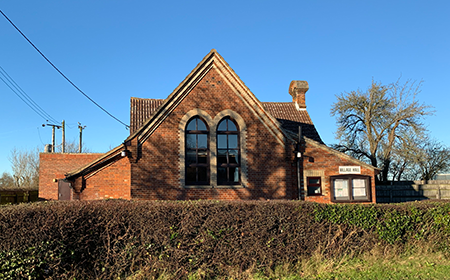 The Village Hall, a central and prominent landmark of Buxhall village, was built in 1877 as a school to accommodate seventy-five children from the village as part of the Education Act of 1870. Though the school itself closed in the mid-1940s, there are plenty of people who remember attending between the ages of five and eleven/twelve. More is said about this in Tony Clayton's book, Hall of Flagons, but suffice it to say, there are a lot of memories attached to this building, including many New Year's Eve and birthday bashes held within the hall. During such times a small bar was stocked, run by the local public house, The Crown. There's something about the smell of beer, a live country band, and couples swaying to a slow twang in the late hours that sends nostalgic chills.
The Village Hall, a central and prominent landmark of Buxhall village, was built in 1877 as a school to accommodate seventy-five children from the village as part of the Education Act of 1870. Though the school itself closed in the mid-1940s, there are plenty of people who remember attending between the ages of five and eleven/twelve. More is said about this in Tony Clayton's book, Hall of Flagons, but suffice it to say, there are a lot of memories attached to this building, including many New Year's Eve and birthday bashes held within the hall. During such times a small bar was stocked, run by the local public house, The Crown. There's something about the smell of beer, a live country band, and couples swaying to a slow twang in the late hours that sends nostalgic chills.
It is the regular polling station for local and national elections, and a focal point for the Buxhall Parish Council meetings.
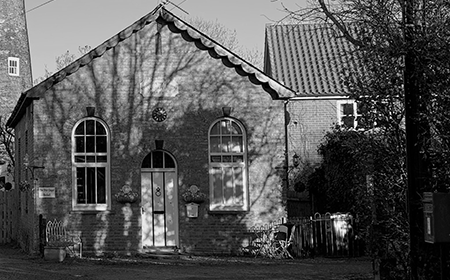 This building sits at the corner of the Buxhall Mill property, facing the oncoming foot and road traffic from the south-west. Its backdrop is the Buxhall Mill tower, making it quite a striking postcard picture. Fifteen years before Buxhall Methodist Chapel was built, the enthusiastic Primitive Methodists held their weekly evening meetings by candlelight in an old thatched cottage in the village. Much fundraising was done for a more legitimate place of worship, and with the money raised, along with a piece of land donated to the cause by the Clover family—the then owners of Buxhall Mill—work was able to proceed to build the chapel seen today. On 28th May 1875 a silver trowel
was presented to lay the foundation stone.
This building sits at the corner of the Buxhall Mill property, facing the oncoming foot and road traffic from the south-west. Its backdrop is the Buxhall Mill tower, making it quite a striking postcard picture. Fifteen years before Buxhall Methodist Chapel was built, the enthusiastic Primitive Methodists held their weekly evening meetings by candlelight in an old thatched cottage in the village. Much fundraising was done for a more legitimate place of worship, and with the money raised, along with a piece of land donated to the cause by the Clover family—the then owners of Buxhall Mill—work was able to proceed to build the chapel seen today. On 28th May 1875 a silver trowel
was presented to lay the foundation stone.
The chapel was closed as a public place of worship in September 1998 and is now a private residence. The words Primitive Methodist Chapel 1875 still proudly adorns the front of the building.
 There were once Post Offices everywhere—the written word, telegram and telephone—communication hubs in every city, town and village. Buxhall was no exception, though the village Post Office closed in 1975 after the last postmistress, Eleanor Fosker (nee Sawyer), retired, having taken over from her mother in 1956. The Old Forge sits next to the old Post Office, and was run by Eleanor's husband, Stanley. There are many names and families who have been in the village for generations, and the Fosker family are one of the most loved in memory.
There were once Post Offices everywhere—the written word, telegram and telephone—communication hubs in every city, town and village. Buxhall was no exception, though the village Post Office closed in 1975 after the last postmistress, Eleanor Fosker (nee Sawyer), retired, having taken over from her mother in 1956. The Old Forge sits next to the old Post Office, and was run by Eleanor's husband, Stanley. There are many names and families who have been in the village for generations, and the Fosker family are one of the most loved in memory.
Both the Post Office cottage and the converted Old Forge buildings are now private residences, but the raised decoration showing the Royal Crown and the words POST OFFICE can still be seen above the door. A little piece of history, almost camouflaged, yet still there for anyone who cares to look.
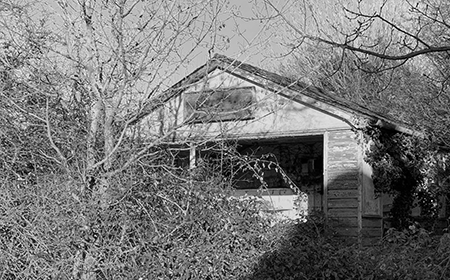 This very run down looking structure is a curiosity. It may look like an old shed at first glance, but this was the third or fourth site of the Buxhall Village shop. The curiosity of it is that it sits almost opposite a T-junction, back in what is now tree and bush, its wooden boards once apparently blue, now flaked and worn. Yet this must have been quite a hub at one point, for if you want to buy anything nowadays, you have to travel miles in any direction out of the village. With no pub (currently), no post office, and no shops, it is a last look at an era disappearing.
This very run down looking structure is a curiosity. It may look like an old shed at first glance, but this was the third or fourth site of the Buxhall Village shop. The curiosity of it is that it sits almost opposite a T-junction, back in what is now tree and bush, its wooden boards once apparently blue, now flaked and worn. Yet this must have been quite a hub at one point, for if you want to buy anything nowadays, you have to travel miles in any direction out of the village. With no pub (currently), no post office, and no shops, it is a last look at an era disappearing.
Interestingly, I realised only writing this now, I used this image in my mind when writing one of my novels. Amazing what sticks in the subconscious, for this abandoned shop has been sat in decay since my early childhood, for all that I remember.
Relevant Links
- Buxhall Parish Council
- Some of St. Mary's Church text sourced from buxhallfete.co.uk
† Some historical text sourced from Hall of Flagons by Tony Clayton
St. Mary's Church
 Obviously, this large and beautiful church has not disappeared from view, and can actually be seen from many of the surrounding villages, and it is still in use by the Church of England today as Buxhall Parish Church. It is one of seven churches within the Combs and Finborough Group.
Obviously, this large and beautiful church has not disappeared from view, and can actually be seen from many of the surrounding villages, and it is still in use by the Church of England today as Buxhall Parish Church. It is one of seven churches within the Combs and Finborough Group.The current church dates mainly from the early 14th , but is believed to be preceded by at least two others. It is built mainly of flint with an imposing tower 95 inches in height. Outside, the south porch has a niche above for the image of the Virgin Mary. The interior of the church was renovated in the 1870’s but many earlier features remain. The octagonal font is mid 14th century and at each corner a buttress rises from a human head. Some medieval glass still survives in the chancel, and there is other glass in the south nave windows - all in excellent condition. Also in the chancel are three marble floorheads, one dated 1692, another 1584, and the painted arms of George 1. The chancel roof was rebuilt in 1656 and is carved with the initials J.H. F.G and T.C. St Mary’s has six bells – the tenor weighing an impressive 15cwt. The bells are in regular use today.
The Old Mill
 The first reference to a mill in the village was in the Domesday Book of 1086 and was probably a water mill, sited south of the present mill below Kiln Lane, where once there must have been a good head of water. However, the current standing mill was built in 1860 by Isaac Clover, on the site of previous iterations. At the time it hosted eleven-bay sails spanning eighty feet, and at ninety feet high, with a twenty foot dome, it once took the record of being the highest mill in England, the previous record holder being a mill in Great Yarmouth at one hundred and twenty feet.
The first reference to a mill in the village was in the Domesday Book of 1086 and was probably a water mill, sited south of the present mill below Kiln Lane, where once there must have been a good head of water. However, the current standing mill was built in 1860 by Isaac Clover, on the site of previous iterations. At the time it hosted eleven-bay sails spanning eighty feet, and at ninety feet high, with a twenty foot dome, it once took the record of being the highest mill in England, the previous record holder being a mill in Great Yarmouth at one hundred and twenty feet.After a great storm on 30th November 1929, its sails were removed and never replaced, though the mill continued to be in operation until the early 1970s. A cap has since been placed upon the top of the tower to stop any further water damage. Locally, this monument to a more industrious era of the village, is referred to as the candlestick, and to perambulate around the village is know to be walking 'round the candlestick.
The Old School - The Village Hall
 The Village Hall, a central and prominent landmark of Buxhall village, was built in 1877 as a school to accommodate seventy-five children from the village as part of the Education Act of 1870. Though the school itself closed in the mid-1940s, there are plenty of people who remember attending between the ages of five and eleven/twelve. More is said about this in Tony Clayton's book, Hall of Flagons, but suffice it to say, there are a lot of memories attached to this building, including many New Year's Eve and birthday bashes held within the hall. During such times a small bar was stocked, run by the local public house, The Crown. There's something about the smell of beer, a live country band, and couples swaying to a slow twang in the late hours that sends nostalgic chills.
The Village Hall, a central and prominent landmark of Buxhall village, was built in 1877 as a school to accommodate seventy-five children from the village as part of the Education Act of 1870. Though the school itself closed in the mid-1940s, there are plenty of people who remember attending between the ages of five and eleven/twelve. More is said about this in Tony Clayton's book, Hall of Flagons, but suffice it to say, there are a lot of memories attached to this building, including many New Year's Eve and birthday bashes held within the hall. During such times a small bar was stocked, run by the local public house, The Crown. There's something about the smell of beer, a live country band, and couples swaying to a slow twang in the late hours that sends nostalgic chills.It is the regular polling station for local and national elections, and a focal point for the Buxhall Parish Council meetings.
The Old Methodist Chapel
 This building sits at the corner of the Buxhall Mill property, facing the oncoming foot and road traffic from the south-west. Its backdrop is the Buxhall Mill tower, making it quite a striking postcard picture. Fifteen years before Buxhall Methodist Chapel was built, the enthusiastic Primitive Methodists held their weekly evening meetings by candlelight in an old thatched cottage in the village. Much fundraising was done for a more legitimate place of worship, and with the money raised, along with a piece of land donated to the cause by the Clover family—the then owners of Buxhall Mill—work was able to proceed to build the chapel seen today. On 28th May 1875 a silver trowel
was presented to lay the foundation stone.
This building sits at the corner of the Buxhall Mill property, facing the oncoming foot and road traffic from the south-west. Its backdrop is the Buxhall Mill tower, making it quite a striking postcard picture. Fifteen years before Buxhall Methodist Chapel was built, the enthusiastic Primitive Methodists held their weekly evening meetings by candlelight in an old thatched cottage in the village. Much fundraising was done for a more legitimate place of worship, and with the money raised, along with a piece of land donated to the cause by the Clover family—the then owners of Buxhall Mill—work was able to proceed to build the chapel seen today. On 28th May 1875 a silver trowel
was presented to lay the foundation stone.The chapel was closed as a public place of worship in September 1998 and is now a private residence. The words Primitive Methodist Chapel 1875 still proudly adorns the front of the building.
The Old Post Office
 There were once Post Offices everywhere—the written word, telegram and telephone—communication hubs in every city, town and village. Buxhall was no exception, though the village Post Office closed in 1975 after the last postmistress, Eleanor Fosker (nee Sawyer), retired, having taken over from her mother in 1956. The Old Forge sits next to the old Post Office, and was run by Eleanor's husband, Stanley. There are many names and families who have been in the village for generations, and the Fosker family are one of the most loved in memory.
There were once Post Offices everywhere—the written word, telegram and telephone—communication hubs in every city, town and village. Buxhall was no exception, though the village Post Office closed in 1975 after the last postmistress, Eleanor Fosker (nee Sawyer), retired, having taken over from her mother in 1956. The Old Forge sits next to the old Post Office, and was run by Eleanor's husband, Stanley. There are many names and families who have been in the village for generations, and the Fosker family are one of the most loved in memory.Both the Post Office cottage and the converted Old Forge buildings are now private residences, but the raised decoration showing the Royal Crown and the words POST OFFICE can still be seen above the door. A little piece of history, almost camouflaged, yet still there for anyone who cares to look.
The Old Village Shop
 This very run down looking structure is a curiosity. It may look like an old shed at first glance, but this was the third or fourth site of the Buxhall Village shop. The curiosity of it is that it sits almost opposite a T-junction, back in what is now tree and bush, its wooden boards once apparently blue, now flaked and worn. Yet this must have been quite a hub at one point, for if you want to buy anything nowadays, you have to travel miles in any direction out of the village. With no pub (currently), no post office, and no shops, it is a last look at an era disappearing.
This very run down looking structure is a curiosity. It may look like an old shed at first glance, but this was the third or fourth site of the Buxhall Village shop. The curiosity of it is that it sits almost opposite a T-junction, back in what is now tree and bush, its wooden boards once apparently blue, now flaked and worn. Yet this must have been quite a hub at one point, for if you want to buy anything nowadays, you have to travel miles in any direction out of the village. With no pub (currently), no post office, and no shops, it is a last look at an era disappearing.Interestingly, I realised only writing this now, I used this image in my mind when writing one of my novels. Amazing what sticks in the subconscious, for this abandoned shop has been sat in decay since my early childhood, for all that I remember.
Relevant Links
- Buxhall Parish Council
- Some of St. Mary's Church text sourced from buxhallfete.co.uk
† Some historical text sourced from Hall of Flagons by Tony Clayton
